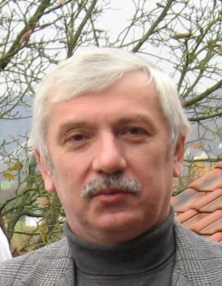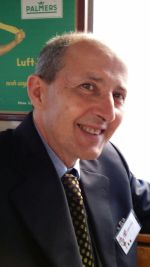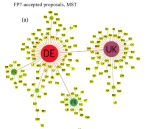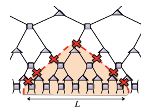News
Virginie SERIN and Luis VINA new Co-Editors-in-Chief of EPJ Applied Physics
- Details
- Published on 12 January 2015
EPJAP is pleased to announce the appointment of Prof. Virginie Serin and Prof. Luis Viña as the journal’s new co-Editors-in-Chief. They will form an interdisciplinary leadership team for the journal.
Prof Virginie Serin and Prof Luis Viña’s terms begin on January 1, 2015. They are replacing Bernard Drévillon, who had served as Editor-in-Chief since the beginning of 2003. The new team will do its best to continue to build on the great work that their predecessor Bernard Drévillon has achieved during his term to further increase the global reach of the Journal, and to promote and encourage the recent progresses in the field of Applied Physics.
EPJ D North American Regional Editor
- Details
- Published on 08 January 2015

New Editors-in-Chief for EPJ D
- Details
- Published on 08 January 2015
December 31st, 2014 marked the end of the terms of appointment of two of the Editors-in-Chief for EPJD, Professor Kurt Becker (New York University, USA) and Professor Nigel Mason (Open University, UK). Profs Becker and Mason have served as Editors-in-Chief since 2009, representing the fields of plasma physics and atomic and molecular physics respectively. Under their leadership the journal has seen substantial growth and development across a broad range of topical areas, with special issues published in diverse fields including microplasmas, electron-positron collision physics, cluster physics and radiation biodamage. The publishers would like to express their sincere appreciation to Kurt and Nigel for their service to the journal and the wider community as Editors-in-Chief over the past five years.
We are delighted to announce the appointment of their successors, starting from 1st January 2015.
EPJ D Colloquium - Quantum optics with quantum dots
- Details
- Published on 22 December 2014

The aim of quantum information research is to harness the distinctive features of quantum physics, especially superposition and entanglement, to enhance the functionality and power of information and communication technologies. It has been a thriving interdisciplinary field of research for the last thirty years, extending from the fundamental investigation of quantum phenomena to the experimental implementation of disruptive quantum-enabled technologies.
EPJE: Francesco Sciortino joins the EPJE board as Editor in Chief
- Details
- Published on 19 December 2014

Author contribution statement
- Details
- Published on 15 December 2014
Authors submitting to the EPJ Open journals EPJ DS, EPJ TI, EPJ QT and EPJ NBP are asked to give details of how each author contributed to the work reported in the publication, and their statement becomes visible at the end of the paper. This practice is relatively new in physics journals. As the size and internationality of scientific collaborations has grown, the number of co-authors on each paper has increased. In many cases the conventions about authors listing developed in certain fields or countries are often insufficient and in some cases collide with each other. On the other hand, academics face mounting pressure to be more transparent about their work and to provide quantitative metrics of their contribution to science and society, beyond the number of citations to their papers. A further important consideration is ethics. Inclusion of authors who have not participated in the work reported is unethical, as is the exclusion of names who have actually given a contribution. Such disputes over authorship do arise, accompanied by unwieldy arguments, which journal editors find difficult to resolve. The request for a statement detailing each author’s contribution is meant to heighten awareness of all these issues when submitting a paper. From now on EPJ B, D and E will start requesting an author contribution statement for multi-authored papers.
EPJ B Highlight - Winner and losers of the EU funding challenge
- Details
- Published on 10 December 2014

Successfully attracting EU funding could depend on the nature of the research consortium
The European Union has a well-oiled funding mechanism in the form of grants given to research consortia. These are essentially made up of collaborating academic and industry-based research organisations. Understanding which type of consortium work receives funding could help future applicants. And it could also bring further transparency on how public funds are spent. Now, Maria Tsouchnika and Panos Argyrakis from the University of Thessaloniki, Greece, have brought valuable insights into the structure of research consortia that are most likely to attract EU funding, in a paper published in EPJ B.EPJ E Highlight - Biomimetic dew harvesters
- Details
- Published on 02 December 2014

Understanding how a desert beetle harvests water from dew could help to improve drinking water collection in dew condensers mimicking the nanostructure of the beetle’s back
Insects are full of marvels—and this is certainly the case with a beetle from the Tenebrionind family, found in the extreme conditions of the Namib desert. Now, a team of scientists has demonstrated that such insects can collect dew on their backs—and not just fog as previously thought. This is made possible by the wax nanostructure on the surface of the beetle’s elytra. These findings by José Guadarrama-Cetina, then working at ESPCI ParisTech, France—on leave from the University of Navarra, in Spain—and colleagues were recently published in EPJ E. They bring us a step closer to harvesting dew to make drinking water from the humidity in the air. This, the team hopes, can be done by improving the water yield of man-made dew condensers that mimick the nanostructure on the beetle’s back.
EPJ B Highlight - When noise gets electrons moving
- Details
- Published on 02 December 2014

A new study demonstrates the existence of a counter-intuitive current, induced by the sound-based equivalent of a laser, with applications in novel microscopic semiconductor devices
Studying the motion of electrons in a disordered environment is no simple task, mainly because given the effect occurring at the scale of interest—referred to as quantum scale—these electrons are otherwise impossible to examine, due to the presence of incidental phenomena. Often, understanding such effects requires a quantum simulator designed to expose them in a different physical setup. This is precisely the approach adopted by Denis Makarov and Leonid Kon’kov from the Victor I. Il’ichev Pacific Oceanological Institute in Vladivostok in a new study published in EPJ B. They relied on a simulator of electronic motion subjected to noise stemming from a flux of sound waves. These findings could lead to semi-conductor devices of a new kind, operated through acoustic radiations.
EPJ B Colloquium - Tensor network theory
- Details
- Published on 01 December 2014

Tensor Network (TN) states are a new language, based on entanglement, for quantum many-body states. Román Orús, in a new EPJ B Colloquium, reviews four theoretical developments in TN states for strongly correlated systems.





